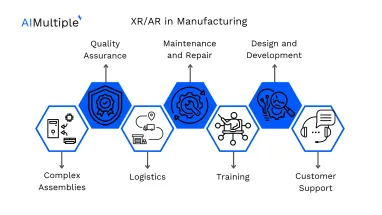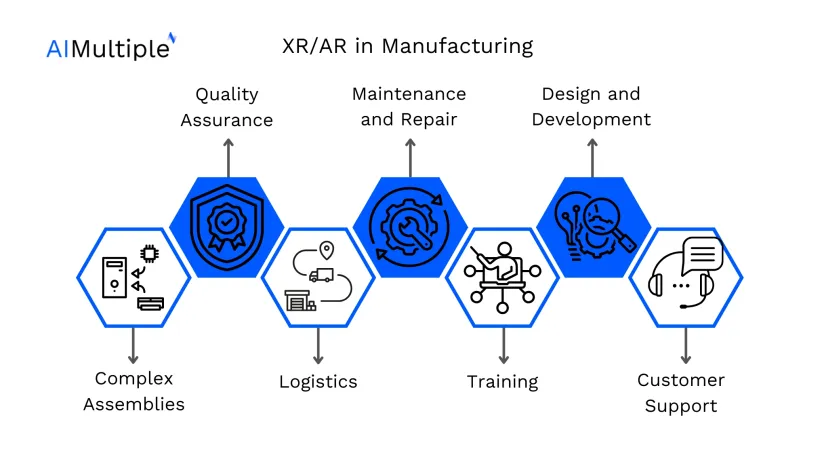Extended reality (XR) technologies have been increasingly adopted over the past few years in the manufacturing industry. Utilizing VR/AR technology in the manufacturing sector can provide a $360 billion boost to GDP by 2030.
VR/AR solutions are still far from widespread adoption, and business leaders might be unaware of the use cases and benefits of implementing AR/VR in manufacturing operations. We explore the top 7 use cases of XR/AR in manufacturing with real-world examples.
1- Complex assemblies
Virtual reality solutions can be used to simulate assembly scenarios and train workers on how to assemble products in a safe and efficient manner. Augmented reality can be used to overlay work instructions or information utilizing AR glasses (smart glasses), making it easier for workers to understand and complete the assembly process. Additionally, XR technologies can be used to collaborate remotely on assembly tasks, enabling experts to guide and assist workers in other locations. Overall, using XR technologies can improve assembly processes’ efficiency, accuracy, and safety.
Real-life example
Airbus utilizes Microsoft HoloLens 2 AR glasses in assembly tasks to guide workers with easy access to visual data points which simplifies complex assembly processes with step-by-step instructions.
2- Quality assurance
AR technology can aid quality assurance in several ways:
- Visual Inspection: AR can overlay digital data on top of real-world objects, making it easier for workers to identify defects or deviations from quality standards.
- Training: AR can be used to train employees on how to perform quality assurance tasks, such as how to properly inspect a product or identify defects.
- Remote Assistance: AR can be used to provide real-time assistance from experienced workers while performing quality assurance tasks, allowing experts to remotely guide workers and ensure that quality standards are met.
- Data Collection: AR can be used to gather data on the quality assurance process, such as the number of defects identified, time spent on inspection, and other relevant metrics.
Overall, the use of AR technology can improve the efficiency, accuracy, and consistency of quality assurance processes, helping to ensure that products meet quality standards and customer expectations.
For a comprehensive overview of how artificial intelligence enhances augmented reality, refer to our article on AI Applications & Use Cases of Augmented Reality.
Real-life example
Taqtile’s mobile AR solution, Manifest, enhances quality inspections by providing workers with step-by-step, visual instructions directly in their field of view, ensuring standardized procedures and reducing errors. The platform allows real-time fault reporting, automatic data capture, and remote assistance from experts, making it easier to address and document issues during inspections.
3- Logistics
Augmented reality eases asset identification and asset management with spatial computing, which streamlines warehouse operations. With AR glasses, workers can access inventory data on the move and navigate the warehouse efficiently and safely while keeping their hands free.
Deploying AR also enables more efficient scheduling and planning since warehouse operatives can get quick access to the following data:
- Data from production lines
- Data from sales teams
- Inventory data
Real-life example
Due to visual representation, data access, and decreased equipment downtime warehouse operations can be made more efficient, resulting in a reduced overall supply chain lead time. The video below demonstrates how augmented reality can enhance warehouse operational efficiency.
4- Maintenance and repair
Augmented reality can be used to overlay instructions and diagrams onto real-world equipment during repairs, allowing technicians to identify and fix issues. Seeing contextualized information in real-time eliminates guesswork and allows technicians to fasten the maintenance process. Augmented reality also enables smooth knowledge transfer by allowing technicians to view related material (manuals, guides, etc.) or via video conferencing with a remote expert. Overall, AR enhances maintenance and repair by enabling:
- Faster problem diagnosis
- Speeding up maintenance and repair tasks
- Standardizing procedures and reducing human error
- Decreasing equipment downtimes
- Eliminating expert travel costs
Real-life example
Vuforia’s augmented reality (AR) solutions streamline maintenance and repair tasks by providing technicians with real-time, in-context guidance. By overlaying 3D work instructions directly onto equipment, Vuforia enables technicians to perform complex procedures accurately and efficiently. This approach reduces reliance on traditional manuals, accelerates repair times, and enhances first-time fix rates.
5- Training
The manufacturing sector involves high-risk jobs, which account for 20% of workplace injuries in the UK with only 10% of the workforce.1 Health and safety should be top priorities for manufacturing companies, which is achievable through effective training. Utilizing AR/VR in both soft skill and technical training is proven to increase:
- Knowledge retention
- Trainee engagement
- Training efficiency
- Workplace safety
The manufacturing industry involves complex and dangerous equipment that employees have to operate, which requires training. Studies suggest that 70% of skills and knowledge are learned on the job, which indicates that training solutions should offer realistic scenarios and hands-on methods. Virtual reality solutions allow new workers to train in a safe and controlled environment in which to practice and learn. This allows them to learn and make mistakes without the risk of damaging real equipment or causing costly downtime.
VR/AR devices also offer features such as eye tracking and hand tracking, which can be used to pinpoint bottlenecks and problems employees face in training. Utilizing performance indicators ensure training is completed correctly.
Real-life example
PBC Linear uses augmented reality (AR) to streamline training in advanced manufacturing by providing workers with interactive, step-by-step instructions through Taqtile’s Manifest platform. This approach allows PBC Linear to convert expert knowledge into accessible digital guides, reducing training time significantly and helping ensure consistency in their processes. With AR, new employees can follow visual instructions directly in their workspace, making it easier to learn tasks accurately without needing extensive oversight.
6- Design and development
AR/VR solutions assist manufacturing businesses by easing multiple steps of the product development cycle, such as prototyping and design refinement. Utilizing virtual objects saves time and money since physical prototypes are pricy, hard to duplicate, and extremely lengthy. Being able to design in 3D fastens the design process because it provides the “real world image”, understanding and visualizing the end product in 3D facilitates user-centric design.
AR/VR also enables collaboration without location boundaries which is useful in review and creative processes.
These AR-driven interfaces are often powered through APIs and real-time data streams. For example, Telecom providers supporting such use cases may rely on telecom APIs to deliver fast, reliable connections for remote maintenance, AR-guided support, or mobile interfaces on the factory floor.
Real-life example
McLaren Automotive integrates virtual reality (VR) into its design process to enhance efficiency and precision in developing sports and supercars. By collaborating with software company Vector Suite, McLaren employs VR to create immersive 3D models during the early stages of design. This approach allows designers to visualize and refine vehicle concepts in real-time, facilitating rapid iterations and informed decision-making. The use of VR streamlines the transition from 2D sketches to 3D models, reducing development time and improving the overall design quality.
7- Customer support
AR applications also help customers get effective remote assistance from qualified experts with AR interfaces that provide in-context instructions. AR is useful in:
- Product introduction and installation
- Product maintenance
- Defect detection and repair tasks
Real-life example
SMA Solar Technology AG enhances customer support through augmented reality (AR) applications, notably the SMA Remote and SMA Virtual Support apps.




Comments
Your email address will not be published. All fields are required.